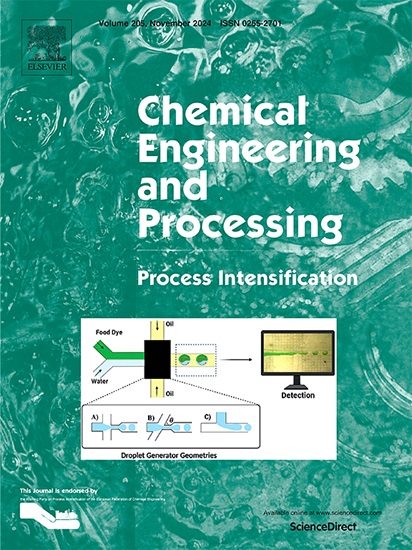Heat resistance network model of corrugated honeycomb monolith catalysts based on heat flux field
IF 3.8
3区 工程技术
Q3 ENERGY & FUELS
Chemical Engineering and Processing - Process Intensification
Pub Date : 2025-04-09
DOI:10.1016/j.cep.2025.110315
引用次数: 0
Abstract
The energy conversion between hydrogen, ammonia, methanol and liquid fuel is often accompanied by strong exothermic or endothermic heterogeneous catalytic reactions. Different metal substrate structured catalysts were used for heat transfer enhancement in our previous literature. In this paper, the enhancement mechanism was further studied by numerical simulation. The results showed that increasing the heat conductivity of the material and improving the structural integrity are effective methods to enhance the effective radial heat conductivity. Then, the heat resistance networks of corrugated honeycomb substrate structured catalysts composed of several local heat resistances were derived through theoretical analysis. The heat flux field was applied to modify the heat resistance networks, and the error was lower than 10 %. The total heat resistance of rolling FeCrAl substrate and selective laser melting AlSiMg substrate were calculated according to the heat resistance network, and verified by simulation results. The results showed that the AlSiMg substrate reduced total heat resistance by 93 % compared to FeCrAl substrate. Finally, the difference between AlSiMg and FeCrAl substrate was analyzed by analyzing local heat resistance, and the structural optimization method was proposed.

基于热流场的瓦楞蜂窝整体催化剂耐热网络模型
氢、氨、甲醇和液体燃料之间的能量转换往往伴随着强烈的放热或吸热非均相催化反应。在我们以前的文献中,不同的金属衬底结构催化剂被用于强化传热。本文通过数值模拟进一步研究了强化机理。结果表明,提高材料导热系数和提高结构完整性是提高材料径向有效导热系数的有效方法。然后,通过理论分析,推导出由多个局部热阻组成的波纹蜂窝衬底结构催化剂的耐热网络。采用热流场对热阻网络进行修正,误差小于10%。根据热阻网络计算了轧制FeCrAl基板和选择性激光熔化AlSiMg基板的总热阻,并通过仿真结果进行了验证。结果表明,与FeCrAl衬底相比,AlSiMg衬底的总耐热性降低了93%。最后,通过分析AlSiMg和FeCrAl衬底的局部耐热性,分析两者的差异,并提出结构优化方法。
本文章由计算机程序翻译,如有差异,请以英文原文为准。
求助全文
约1分钟内获得全文
求助全文
来源期刊
CiteScore
7.80
自引率
9.30%
发文量
408
审稿时长
49 days
期刊介绍:
Chemical Engineering and Processing: Process Intensification is intended for practicing researchers in industry and academia, working in the field of Process Engineering and related to the subject of Process Intensification.Articles published in the Journal demonstrate how novel discoveries, developments and theories in the field of Process Engineering and in particular Process Intensification may be used for analysis and design of innovative equipment and processing methods with substantially improved sustainability, efficiency and environmental performance.

 求助内容:
求助内容: 应助结果提醒方式:
应助结果提醒方式:


